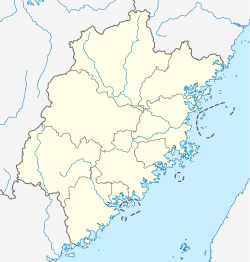
Back Quanzhou Afrikaans Quanzhou ALS تشوانتشو Arabic Quanzhou Catalan Ciòng-ciŭ CDO Quanzhou (kapital sa prepektura sa Pangmasang Republika sa Tśina) CEB Čchüan-čou Czech Quanzhou Danish Quanzhou German Ĉjuanĝoŭ Esperanto
Quanzhou
泉州市 Chinchew | |||||||||||||||||
|---|---|---|---|---|---|---|---|---|---|---|---|---|---|---|---|---|---|
Clockwise from top: Old City of Quanzhou, Zhangping–Quanzhou–Xiaocuo railway over the East Creek, Quanzhou Worker's Cultural Palace, Luoyang Bridge and Chaotian Gate. | |||||||||||||||||
 | |||||||||||||||||
 | |||||||||||||||||
| Coordinates (Quanzhou municipal government): 24°52′28″N 118°40′33″E / 24.8744°N 118.6757°E | |||||||||||||||||
| Administered by | People's Republic of China | ||||||||||||||||
| Claimed by | Republic of China | ||||||||||||||||
| PRC Province | Fujian | ||||||||||||||||
| ROC Province | Fuchien | ||||||||||||||||
| Municipal seat | Fengze District | ||||||||||||||||
| Government | |||||||||||||||||
| • CPC Secretary | Kang Tao | ||||||||||||||||
| • Mayor | Wang Yongli | ||||||||||||||||
| Area | |||||||||||||||||
| • Prefecture-level city | 11,218.91 km2 (4,331.65 sq mi) | ||||||||||||||||
| • Urban | 872.4 km2 (336.8 sq mi) | ||||||||||||||||
| • Metro | 4,274.5 km2 (1,650.4 sq mi) | ||||||||||||||||
| Population (2020 census)[1] | |||||||||||||||||
| • Prefecture-level city | 8,782,285 | ||||||||||||||||
| • Density | 780/km2 (2,000/sq mi) | ||||||||||||||||
| • Urban | 1,728,386 | ||||||||||||||||
| • Urban density | 2,000/km2 (5,100/sq mi) | ||||||||||||||||
| • Metro | 6,669,711 | ||||||||||||||||
| • Metro density | 1,600/km2 (4,000/sq mi) | ||||||||||||||||
| GDP[2] | |||||||||||||||||
| • Prefecture-level city | CN¥ 1.016 trillion US$ 147.3 billion | ||||||||||||||||
| • Per capita | CN¥ 115,768 US$ 18,180 | ||||||||||||||||
| Time zone | UTC+8 (CST) | ||||||||||||||||
| Postal code | 362000 | ||||||||||||||||
| Area code | 0595 | ||||||||||||||||
| ISO 3166 code | CN-FJ-05 | ||||||||||||||||
| License Plate Prefixes | 闽C | ||||||||||||||||
| Local Dialect | Hokkien/Min Nan: Quanzhou dialect | ||||||||||||||||
| Website | www | ||||||||||||||||
| Chinese name | |||||||||||||||||
| Chinese | 泉州 | ||||||||||||||||
| Hokkien POJ | Choân-chiu | ||||||||||||||||
| Postal | Chinchew | ||||||||||||||||
| Literal meaning | "Spring Prefecture" | ||||||||||||||||
| |||||||||||||||||
| Official name | Quanzhou: Emporium of the World in Song-Yuan China | ||||||||||||||||
| Type | Cultural | ||||||||||||||||
| Criteria | iv | ||||||||||||||||
| Designated | 2021 (44th session) | ||||||||||||||||
| Reference no. | 1561 | ||||||||||||||||
| Region | China | ||||||||||||||||
Quanzhou is a prefecture-level port city on the north bank of the Jin River, beside the Taiwan Strait in southern Fujian, People's Republic of China.[a] It is Fujian's largest most populous metropolitan region, with an area of 11,245 square kilometers (4,342 sq mi) and a population of 8,782,285 as of the 2020 census. Its built-up area is home to 6,669,711 inhabitants, encompassing the Licheng, Fengze, and Luojiang urban districts; Jinjiang, Nan'an, and Shishi cities; Hui'an County; and the Quanzhou District for Taiwanese Investment. Quanzhou was China's 12th-largest extended metropolitan area in 2010.
Quanzhou was China's major port for foreign traders, who knew it as Zaiton,[b] during the 11th through 14th centuries. It was visited by both Marco Polo and Ibn Battuta; both travelers praised it as one of the most prosperous and glorious cities in the world. It was the naval base from which the Mongol attacks on Japan and Java were primarily launched and a cosmopolitan center with Buddhist and Hindu temples, Islamic mosques, and Christian churches, including a Catholic cathedral and Franciscan friaries. A failed revolt prompted a massacre of the city's foreign communities in 1357. Economic dislocations—including piracy and an imperial overreaction to it during the Ming and Qing—reduced its prosperity, with Japanese trade shifting to Ningbo and Zhapu and other foreign trade restricted to Guangzhou. Quanzhou became an opium-smuggling center in the 19th century but the siltation of its harbor hindered trade by larger ships.
Because of its importance for medieval maritime commerce, unique mix of religious buildings, and extensive archeological remains, "Quanzhou: Emporium of the World in Song-Yuan China" was inscribed on the UNESCO World Heritage List in 2021.[3]
- ^ "China: Fújiàn (Prefectures, Cities, Districts and Counties) - Population Statistics, Charts and Map".
- ^ 福建省统计局、国家统计局福建调查总队 (August 2021). 《福建统计年鉴-2021》. 中国统计出版社. ISBN 978-7-5037-9510-7. Archived from the original on 1 March 2022. Retrieved 23 December 2021.
- ^ "Quanzhou: Emporium of the World in Song-Yuan China". UNESCO World Heritage Centre. United Nations Educational, Scientific, and Cultural Organization. Retrieved 22 August 2021.
Cite error: There are <ref group=lower-alpha> tags or {{efn}} templates on this page, but the references will not show without a {{reflist|group=lower-alpha}} template or {{notelist}} template (see the help page).
© MMXXIII Rich X Search. We shall prevail. All rights reserved. Rich X Search






